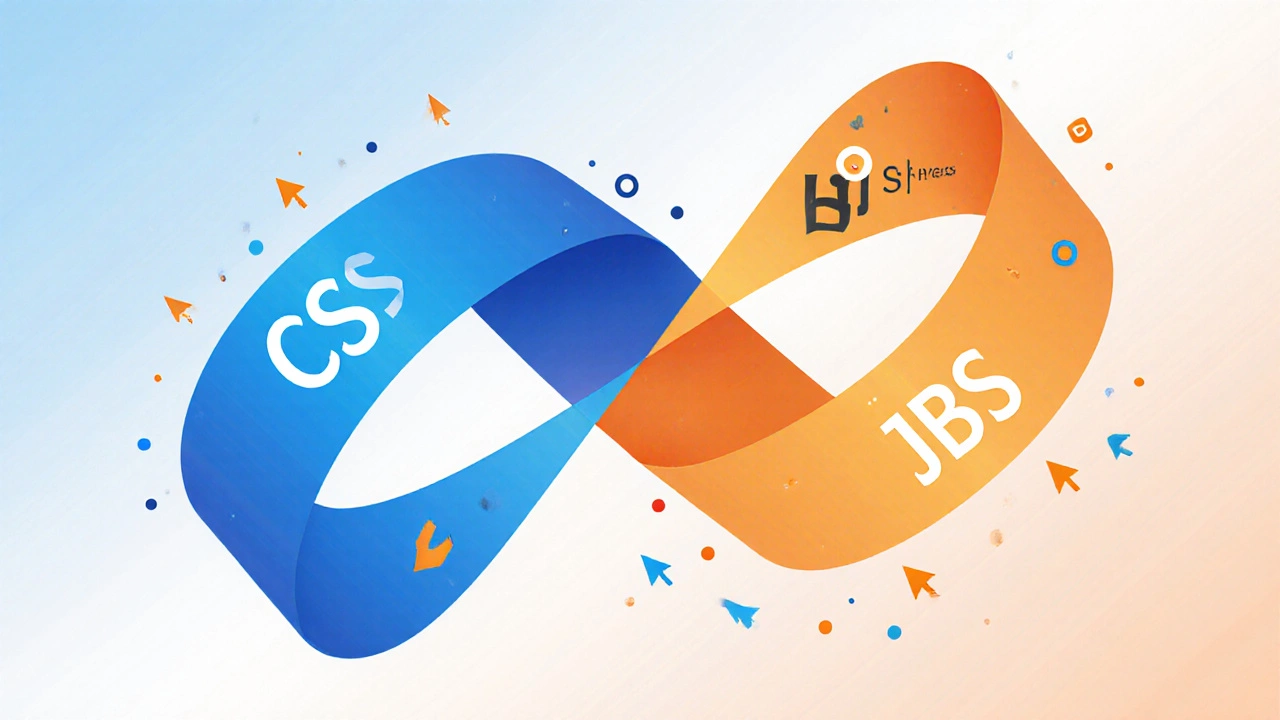CSS/JS Mini-Project Builder
Build a Tiny Project
Create a mini-interactive element by combining CSS styling and JavaScript behavior.
Example: Enter "background-color: #ff0000;" for CSS and "this.style.backgroundColor = '#00ff00';" for JavaScript to make a button change color when clicked.
Enter CSS and JavaScript above to see your interactive element.
You want to build websites. You’ve seen what CSS and JavaScript can do-smooth animations, interactive buttons, layouts that shift perfectly on any screen. But you’re stuck: Can I learn CSS and JavaScript at the same time? The answer isn’t yes or no. It’s how you do it.
Start with CSS first, but don’t wait
Most guides tell you to learn HTML, then CSS, then JavaScript. That’s not wrong-but it’s slow. If you wait to touch JavaScript until you’ve mastered CSS, you’ll spend weeks staring at boxes and margins without seeing anything move. That’s frustrating. And boredom kills momentum. Instead, start with the basics of both at the same time. Learn how CSS styles elements, then immediately use JavaScript to change those styles. For example, write a button in HTML, style it with CSS, then use JavaScript to change its color when clicked. You’ll see the connection between the two right away. CSS gives you structure and appearance. JavaScript gives you behavior. They’re two sides of the same coin. You don’t need to know every CSS property before touching JavaScript. You just need to know enough to make something look like a button, a card, or a menu. Then let JavaScript bring it to life.What you actually need to start
You don’t need to memorize 50 CSS properties or understand event delegation on day one. Here’s what you really need to begin:- CSS: Selectors (class, ID), display: block/inline-block, margin/padding, background-color, font-size, border-radius
- JavaScript: Variables, console.log(), document.querySelector(), element.addEventListener(), element.style.property
Why learning them together works better
When you learn CSS and JavaScript separately, you treat them like isolated tools. But in real websites, they’re always working together. A form validation error? That’s JavaScript detecting the problem and CSS showing the red border. A dropdown menu? CSS animates the slide-down; JavaScript opens and closes it. Learning them together trains your brain to think in systems, not silos. You start seeing how a change in one affects the other. That’s exactly what you’ll do on the job. A 2023 survey by Stack Overflow showed that 87% of front-end developers use CSS and JavaScript together daily. Only 12% said they work on one without the other. The tools are designed to be used side by side. So why learn them apart?
Common mistakes to avoid
People jump into this too fast and burn out. Here’s what goes wrong-and how to fix it:- Mistake: Trying to build a full app on day one. Fix: Stick to small, focused projects. One button. One modal. One animated card.
- Mistake: Copy-pasting JavaScript without understanding it. Fix: Type every line yourself. Even if you don’t get it yet, typing forces your brain to process it.
- Mistake: Ignoring browser dev tools. Fix: Open DevTools (F12) every time you code. Look at the Elements tab to see how CSS applies. Use the Console to test JavaScript commands live.
- Mistake: Waiting to learn HTML fully. Fix: Learn HTML as you go. You only need to know how to write basic tags: div, button, input, p, h1. The rest comes naturally.
How to structure your daily practice
You don’t need hours. You need consistency. Here’s a realistic 15-minute daily plan:- 5 minutes: Review yesterday’s code. What worked? What broke?
- 5 minutes: Write one new line of CSS and one new line of JavaScript that interact. Example: Change the background of a div when you hover over it using JavaScript.
- 5 minutes: Break something on purpose. Delete a semicolon. Change a class name. See what breaks. Then fix it. This builds debugging muscle.

What comes next
After 3-4 weeks of daily practice, you’ll be ready to tackle small real-world tasks:- Build a responsive navigation bar that collapses on mobile
- Create a photo gallery with a lightbox effect
- Make a countdown timer that updates in real time
Real talk: You don’t need perfection
You don’t need to know every CSS property. You don’t need to understand closures or async/await yet. You just need to be able to make a webpage respond to user input. That’s it. Many beginners think they have to learn everything before they can start. That’s a myth. The best developers didn’t wait. They built messy code first. Then they cleaned it up. Then they built again. Your first JavaScript file will be ugly. Your CSS will have redundant rules. That’s normal. That’s how you learn.Final answer: Yes, learn them together
Can you learn CSS and JavaScript at the same time? Absolutely. And you should. They’re not separate subjects. They’re parts of one skill: making websites interactive and beautiful. Start small. Stay consistent. Break things. Fix them. Repeat. In 30 days, you’ll be building things you couldn’t imagine a month ago. And that’s the real win-not knowing every detail, but knowing you can make something work-and then make it better.Do I need to know HTML before learning CSS and JavaScript?
You need basic HTML knowledge-just enough to write elements like divs, buttons, and headings. You don’t need to master every tag or attribute. Learn HTML as you go. Most of what you’ll use is <div>, <button>, <input>, and <img>. The rest comes naturally when you start building projects.
Which should I learn first: CSS or JavaScript?
Start with CSS basics, but don’t wait to start JavaScript. CSS gives you the look; JavaScript gives you the behavior. Learn them side by side. For example, style a button with CSS, then use JavaScript to change its color on click. This connection makes learning stick.
Is it too hard for a complete beginner?
It’s challenging, but not impossible. The key is to avoid overwhelm. Focus on tiny wins: change a color, show a hidden div, make a button work. Don’t try to build an app. Build one interaction. Repeat. Progress comes from consistency, not intensity.
How long until I can build real projects?
With 15-30 minutes a day, you can build simple, real projects in 3-4 weeks. Think: a toggle theme switch, a responsive menu, a photo gallery. These aren’t complex, but they’re functional and impressive to show others. That’s the goal-not perfection, but progress.
Should I use a framework like React right away?
No. Frameworks like React hide the underlying CSS and JavaScript you need to understand. Learn how the browser works first. Build things with plain HTML, CSS, and JavaScript. Once you can do that confidently, frameworks will make sense. Otherwise, you’ll just be copying code without knowing why it works.
